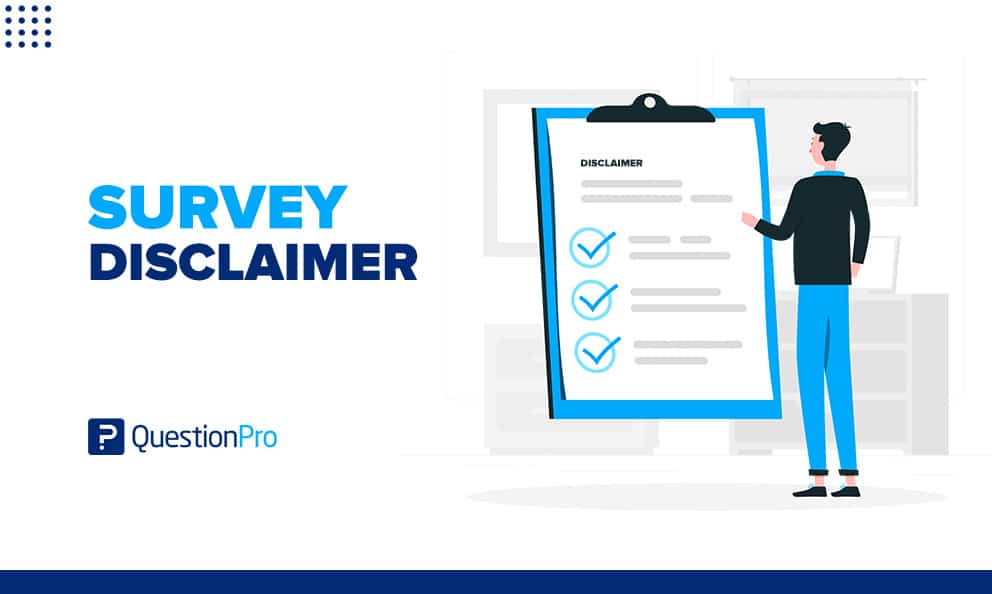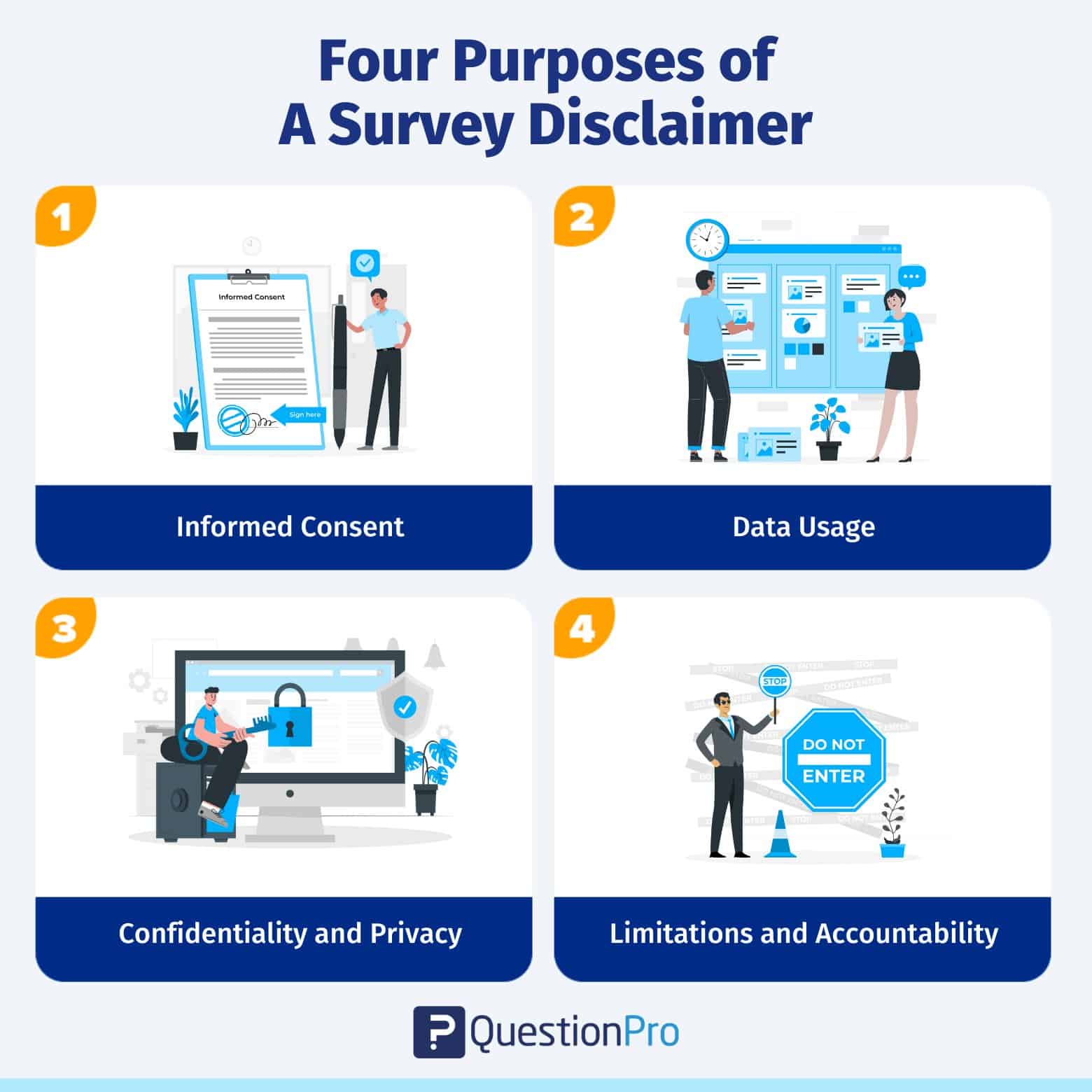
Surveys are an effective means of data collection. However, getting respondents to take an online survey might be difficult if you don’t assure them privacy. Or if they are skeptical about how their answers will be used. After all, everyone wants to know the survey goals and objectives before answering the questions.
The information gathered in this survey disclaimer is solely intended for research purposes. It does not provide personalized medical advice, as our primary aim is to address securing public health concerns on a broader scale.
Adding a disclaimer in the questionnaire is an excellent practice to get more responses. It aids in reassuring the audience that their data is safe. Organizations can stay transparent and let the participants know how their responses will be used.
What is a survey disclaimer?
A survey disclaimer is a way for researchers to reiterate their privacy policies and data security measures. After answering the questionnaire, you can let the survey takers know what they can expect.
A survey disclaimer is a way to ensure that the participants know if their responses will be anonymous or used for any marketing purposes. Organizations can take this opportunity to let them know if their data will be shared with any third party.
Usually, people do not go through the terms and conditions before consenting to the survey. Most participants would quickly glance through the policies and tick the ‘I agree to the terms and conditions.’ checkbox.
Adding a survey consent statement will ensure that the participants know what they are about to do and how their responses will impact the research study.
Why do you need a survey disclaimer statement?
A survey disclaimer or survey consent statement is not mandatory to include in the survey as per the laws. However, many government regulations, such as GDPR, HIPAA, CCPA, and others, aim at protecting consumers’ privacy.
Survey participants might not want their names to be disclosed with sensitive information, so you can let them know about your company’s various data privacy and security measures.
Respondents are reluctant to share their Personal Identifiable Information (PII), such as email addresses, because they fear they will get promotional, spam, or junk emails.
Hence, market research companies should show a survey disclaimer statement before asking the questions and highlight if their PII is safe. If no PII is being collected, mention the purpose of the survey and how the data will be used.
Here are why you should add a survey privacy disclaimer or ask consent questions.
- It increases the credibility of researchers: Respondents will be willing to answer questions once they know their anonymity, privacy, and confidentiality.
- Get more responses: Respondents are likelier to answer questions from a trustworthy organization, increasing the survey response rate.
- Industry best practice: It is good to share with your survey participants that your survey tool and method adhere to various data privacy laws and regulations.
- Allow participants to decide if they want to answer the survey: Let them know how you will use the data, and then give them an option if they want to proceed further. It also emphasizes that respondents’ consent matters to your organization.
Example#1: Survey disclaimer statement
Consider a student who wants to conduct research on alcohol. If the sample audience is evenly distributed, it is likely that a few people may not consume alcohol.
The survey consent statement provides more information about the survey and checks with the participants if they are willing to proceed further with the checkbox ‘I agree”.
LEARN ABOUT: Survey Sample Sizes
Example #2: Anonymous survey example
Researchers often struggle while choosing between the ability to track the respondents and not linking their identity. Keeping responses anonymous ensures the responses are honest and accurate, while the identity details allow researchers to contact respondents if further inputs are required.
QuestionPro allows our users to maintain the privacy and confidentiality of the survey participants with Respondent Anonymity Assurance (RAA). There will be a link to more details for surveys with RAA enabled in the footer. Once it is activated, it cannot be removed or edited by the researchers.
Four purposes of a survey disclaimer
A survey disclaimer is a statement that outlines the terms, intentions, and limitations of a survey, helping respondents understand what to expect and protecting the organization or individual conducting the survey. Here are four key purposes of a survey disclaimer:

1. Informed consent
A survey disclaimer informs respondents about the purpose and objectives of the survey. It ensures that respondents are aware of the data they are providing, how it will be used, and their rights regarding participation. Informed consent is crucial for maintaining ethical research practices and respecting participants’ autonomy.
2. Data usage
The disclaimer clarifies how the collected data will be used. It may explain whether the data will be anonymized, aggregated, or used for specific research purposes. This helps respondents feel more comfortable sharing their information and reduces concerns about their data being misused or shared without their knowledge.
3. Confidentiality and privacy
A survey disclaimer outlines the measures taken to protect respondents’ confidentiality and privacy. This can include assurances that responses will be kept confidential, that no personally identifiable information will be shared, and that data will be stored securely. This transparency encourages respondents to provide honest and accurate information.
4. Limitations and accountability
The disclaimer sets expectations about the limitations of the survey. It may specify that the survey represents only a specific population or may not cover all relevant aspects of a topic. Additionally, disclaimers can clarify the contact information of the survey organizers or researchers, providing a point of contact for respondents to specifically address surveys any concerns or questions they might have.
Important points to consider while drafting a disclaimer for your survey
The disclaimer statement depends on the type and purpose of the survey. For instance, if you are a ride-sharing app asking for feedback after a trip, then there is no need to add a disclaimer. However, if you are conducting a deep medical research study, it is advisable to draft a consent statement for your questionnaire.
Here are some of the basic questions you must answer in the survey disclaimer for your participants.
Q-1: What is the purpose of the survey?
Be explicit about the aim of the study. For instance, you can say, “The responses will be used for general survey disclaimer analytical use only.”
Q-2: How will privacy be maintained?
Respondents’ identity details, such as email address, IP address, location, and country code, are collected unless it is an anonymous survey. You can disclose whether the email address will be linked to the responses in any way.
Q-3: What happens with personal information collected?
Many surveys collect personal data by asking for contact details such as name, address, phone number, etc. Mention if you conduct GDPR compliant market research.
Q-4: Will the data portability be shared with third-party apps?
Nobody wants their inbox flooded with unwanted marketing emails. So, disclose whether the email address or individual responses will be shared with third parties.
Q-5: What is the approximate time taken to complete the survey?
This is optional, but you can mention the number of questions in the survey and the approximate time to answer them so that the respondents know beforehand if they want to proceed.
And last but not least, take consent! Ask questions like ‘Do you wish to proceed further?’ or ‘Do you agree with the terms and conditions?’
Conclusion
A survey disclaimer statement in the questionnaire reflects the values of researchers and agencies. Hence, if you want your respondents to stay loyal and have a good survey experience, you should disclose any necessary information.
A survey implies a legal formality and a critical component of maintaining transparency, trust, and ethical standards in the survey process. Whether you’re a survey creator or a participant, understanding the importance of survey disclaimers can lead to a more informed and responsible approach to data protection, collection, and analysis.
If you need any help with how to draft a disclaimer in the survey or how to design a survey, feel free to reach out to us at [email protected].







